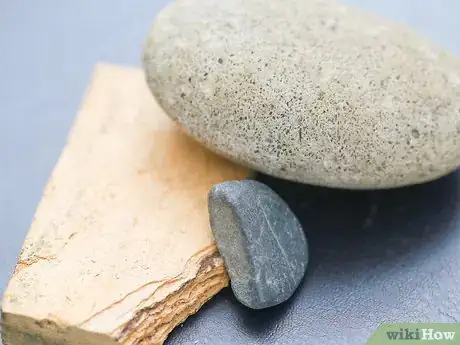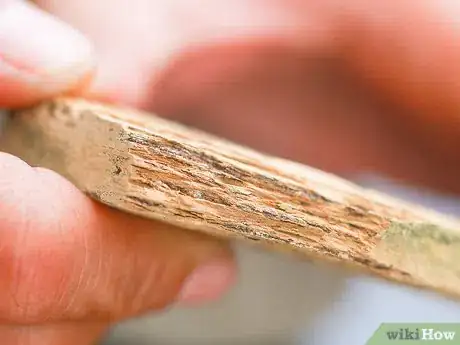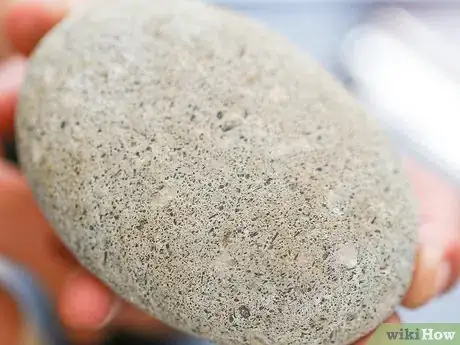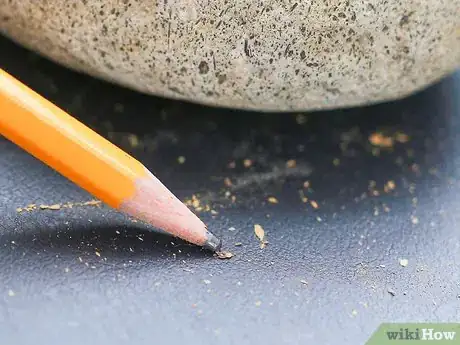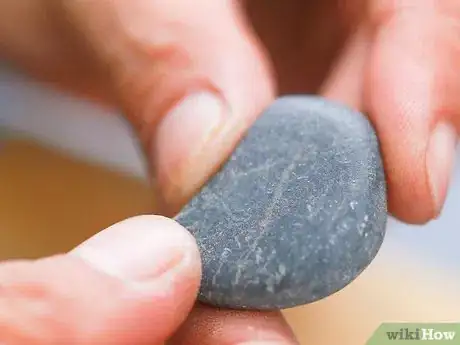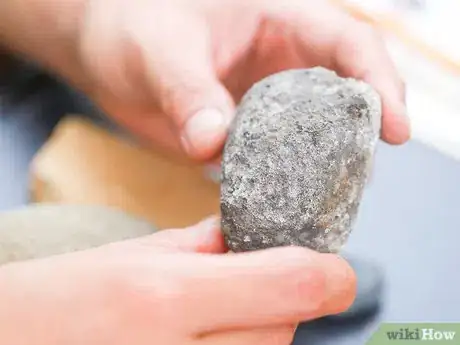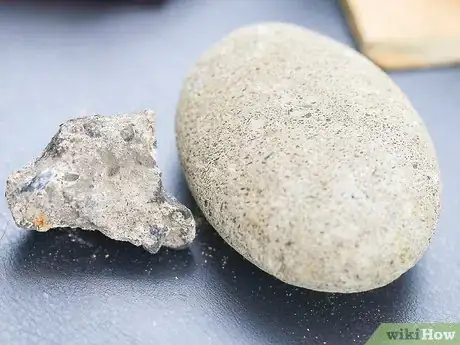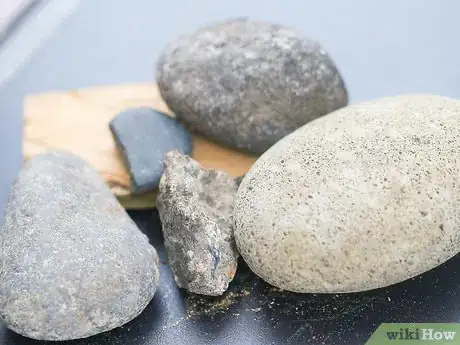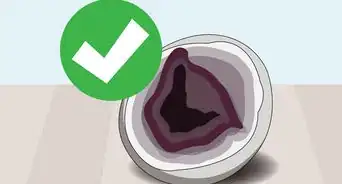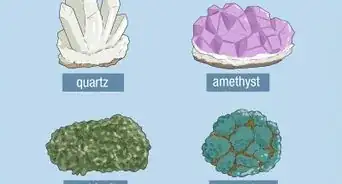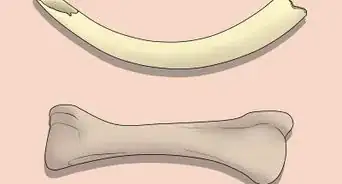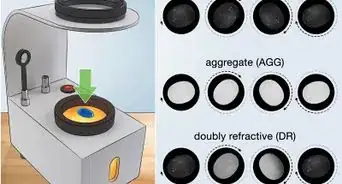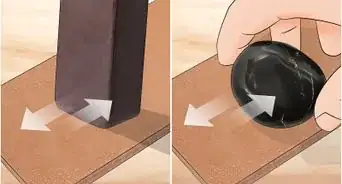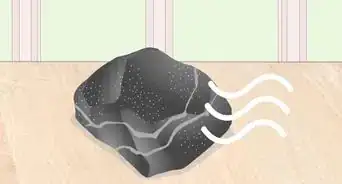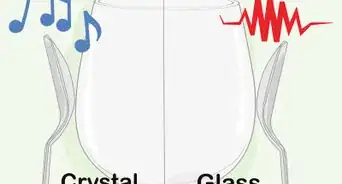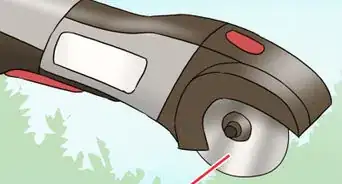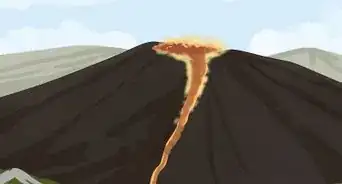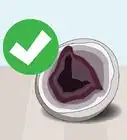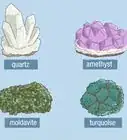This article was co-authored by Sam Lagor, MSc. Sam Lagor is a Geologist with over eight years of experience. He specializes in engineering geology (dams, bridges, and tunnels) and mineral exploration (gold, lead/zinc, andindustrial minerals). Sam holds a BS in Geology from St. Lawrence University and an MS in Geology from The University of Vermont. He is also a member of the Geological Society of America and the American Institute of Professional Geologists.
There are 10 references cited in this article, which can be found at the bottom of the page.
This article has been viewed 355,321 times.
When you hold an igneous rock, the rock you hold in your hand is one of the oldest things in the world. Igneous rocks are formed from lava, magma or ash from a volcanic eruption or flow [1] . By becoming familiar with their distinctive properties, you will not only be able to distinguish them from other types of rocks, you will be able to identify the specific type of igneous rocks they are.
Steps
Identifying Igneous Rocks
-
1Classify igneous rocks into two main types: intrusive or extrusive. Each of these types of rocks will have specific properties that will help you distinguish which type your igneous rock is.[2]
- Magma is molten rock that flows beneath the earth's surface. Igneous rocks are formed by cooling magma.
- The location of the formation of the rock, as well as how fast the magma cools will determine the type of igneous rock.
- Intrusive rocks form from the cooling of magma deep beneath the earth's surface. Since this occurs below the earth's surface, the magma will cool very slowly.[3]
- As magma cools, it will form crystals.
- Intrusive rocks have larger crystals typically formed together to form the rock mass.
- An example of an intrusive rock is granite.
- When magma is above the earth's crust, it is known as lava.
- Extrusive rocks form through very fast cooling of lava above the Earth's surface.
- Extrusive rocks have very small, almost microscopic crystals. These are often described as fine-grained rocks.[4] You usually can't see these with the naked eye.
- The most common type of extrusive rock is basalt.
-
2Identify the texture type of your rock. There are 7 different texture classes for igneous rocks, each with their own unique features. [5]
- Pegmatitic igneous rocks have very large crystals, more than 1 cm in size. These are the slowest cooling type of igneous rocks.
- Remember, the slower a rock cools, the larger the crystals will be.
- Phaneritic igneous rocks are composed of interlocking crystals that are smaller than crystals in pegmatitic but still visible with the naked eye.
- Porphyritic igneous rocks have crystals of two different sizes, often with large crystals set in areas of smaller crystals.
- Aphanitic igneous rocks have a fine-grained texture and most of their crystals are too small to see with the naked eye. You will need to use a magnifying glass to observe the crystals in aphanitic rocks.
- Igneous rocks that form too quickly for crystals to form have what is called a glassy texture. Obsidian is the only glassy igneous rock, and can be identified by its dark color. This looks like dark black glass.
- Vesicular igneous rocks, such as pumice, look bubbly and form before gases are able to escape as lava forms the rock. This also formed with very rapid cooling.
- Pyroclastic igneous rock is a texture composed of volcanic fragments ranging from very fine (ash) to very coarse (tuffs and breccias). [6]
Advertisement -
3Look at the composition of your rock. Composition refers to the percentage of certain minerals in your rock. You will need a rock guide to determine what minerals are present in your rock. There are four main composition types for igneous rocks:[7]
- Identifying the composition of your rock can be very difficult if you are not an experienced rock collector or geologist.
- If you have any questions about how to identify a rock, contact a collector or geologist at a local college or university.
- Felsic igneous rocks are light in color. Their mineral composition is primarily feldspars and silicates such as quartz.
- Granite is an example of a felsic rock.
- Felsic rocks have a low density and contain 0-15% mafic crystals. Mafic minerals are olivine, pyroxene, amphibole, and biotite.
- Mafic igneous rocks are dark in color and consist mainly of magnesium and iron. They contain 46-85% mafic mineral crystals and are high in density.
- Basalt is an example of a mafic rock.
- Ultramafic igneous rocks are also dark in color and contain higher amounts of the minerals found in mafic rocks. These rocks have greater than 85% mafic mineral crystals.
- Dunite is an example of an ultramafic rock.
- Intermediate igneous rocks contain 15-45% mafic mineral crystals. They share minerals with both felsic and mafic rocks and are intermediate in color.
- Diorite is an example of an intermediate rock.
Distinguishing Between Major Rock Types
-
1Know the difference between the three major rock types. The three major rock types are igneous, metamorphic, and sedimentary. [8]
-
2Look at your rock for signs of layering. The presence and distribution of layering can help you identify the main type of rock you have. [12]
- If a rock is layered, it will have different sections that are different colors and may or may not contain small crystals or fossils. You will need to look for these under a magnifying glass.
- In cross section, layers in a rock will look like different colors stripes on top of one another.
- The presence and distribution of layering can help you identify the main type of rock you have.
- Igneous rocks are not layered. If your rock has layers it will be either a metamorphic or sedimentary rock.
- Sedimentary rocks will have layers that are softy and crumbly, and are comprised of mud, sand or gravel.
- Sedimentary rocks can also have crystals. If the layers in your rock are made up of crystals of varying sizes, then your rock is sedimentary.
- Metamorphic rocks have layers made up crystals that are the same size.
- The layers of metamorphic rocks are also folded and deformed.
-
3Examine your rock for signs of visible grains. You should use a magnifying glass to do this, as some grains and crystals can be very tiny and you won't be able to see them with the naked eye. If your rock has visible grains, proceed to the next step to classify your rock based on grain type. If there are no visible grains, use the following criteria to classify your rock:[13]
- Igneous rocks are very dense and hard. They may have a glassy appearance.
- Metamorphic rocks may also have a glassy appearance. You can distinguish these from igneous rocks based on the fact that metamorphic rocks tend to be brittle, lightweight, and an opaque black color.
- Sedimentary rocks with no grains will resemble dry clay or mud.
- Sedimentary rocks with no grains also tend to be soft, as they can usually be scratched easily with a fingernail. These rocks will also react to hydrochloric acid.
-
4Classify the grain type in your rock. Remember, not all rocks will have visible grains. Grains will appear as small pieces of sand, fossils, or crystals.[14]
- Only metamorphic and sedimentary rocks will contain fossils. Sedimentary rocks may have visible fossils such as whole or partial leaves, shells, footprints etc. Metamorphic rocks will contain only highly fragmented fossils.
- Sedimentary rocks will have grains made up of sand, silt or gravel. These grains may be rounded in shape (clastic), or be made up of other rocks.
- If your grains contain crystals, you can use the orientation and size of the crystals to identify the rock.
- Igneous rocks have crystals that are randomly oriented. They may have large crystals in ground mass with smaller crystals.
- Sedimentary rocks have crystals that are easily broken or scratched.
- Metamorphic rocks contain crystals that have a foliated or scaly appearance. These are often long and arranged in a parallel pattern.
-
5Look at your rock for additional features. You want to look for any type of metallic appearance or streamlined flow structures.[15]
- Rocks that have a metallic appearance with a scaly or smooth texture are metamorphic.
- Igneous rocks may have a vesicular texture. This is when the rock appears to be very porous with many holes.
- Pumice is an example of a rock that has a very porous texture.
- Igneous rocks will be very hard. Many types of igneous rocks have rocky streamlined flow structures in them.
Community Q&A
-
QuestionIs a smooth black stone I found on an old construction site likely to be an obsidian?
 Community AnswerIt could be, it depends on your location. If the rock has a glass-like texture or if you can see rings in it, it is very likely to be obsidian.
Community AnswerIt could be, it depends on your location. If the rock has a glass-like texture or if you can see rings in it, it is very likely to be obsidian. -
QuestionHow do I differentiate between granite and diorite?
 Community AnswerGranite is a felsic intrusive rock and always has a red to pink or orange hue to it depending on how much K-spar it contains. Diorite is an intermediate intrusive rock which has a salt and pepper appearance.
Community AnswerGranite is a felsic intrusive rock and always has a red to pink or orange hue to it depending on how much K-spar it contains. Diorite is an intermediate intrusive rock which has a salt and pepper appearance. -
QuestionHow many layers does an igneous rock have?
 Community AnswerThe common igneous rock (not including obsidian) has between 8 and 13 layers.
Community AnswerThe common igneous rock (not including obsidian) has between 8 and 13 layers.
Things You'll Need
- Magnifying Glass
- Rock Guide
References
- ↑ http://www.arch.dcr.state.nc.us/ncarch/GeoArcheo/RocksA.htm
- ↑ http://hyperphysics.phy-astr.gsu.edu/hbase/geophys/intrus.html
- ↑ https://www.usgs.gov/faqs/what-are-igneous-rocks
- ↑ https://www.usgs.gov/faqs/what-are-igneous-rocks
- ↑ http://www.arch.dcr.state.nc.us/ncarch/GeoArcheo/GlossaryA.htm
- ↑ http://www.pitt.edu/~cejones/GeoImages/2IgneousRocks/IgneousTextures/9Pyroclastic.html
- ↑ http://www.arch.dcr.state.nc.us/ncarch/GeoArcheo/GlossaryA.htm
- ↑ http://www.arch.dcr.state.nc.us/ncarch/GeoArcheo/GlossaryA.htm
- ↑ https://www.nationalgeographic.org/encyclopedia/igneous-rocks/
- ↑ https://www.usgs.gov/faqs/what-are-metamorphic-rocks
- ↑ https://en.wikipedia.org/wiki/Sedimentary_rock
- ↑ http://www.arch.dcr.state.nc.us/ncarch/GeoArcheo/IgneousSedimentaryMetamorphic.pdf
- ↑ http://www.arch.dcr.state.nc.us/ncarch/GeoArcheo/IgneousSedimentaryMetamorphic.pdf
- ↑ http://www.arch.dcr.state.nc.us/ncarch/GeoArcheo/IgneousSedimentaryMetamorphic2.pdf
- ↑ http://www.arch.dcr.state.nc.us/ncarch/GeoArcheo/IgneousSedimentaryMetamorphic2.pdf
About This Article
Igneous rocks are formed from lava, magma, or ash from volcanic eruptions or flow and can often be distinguished by there crystals. Igneous rocks formed by magma have large crystals that came together to make the rock mass. Alternatively, igneous rocks formed by lava have very small, microscopic crystals that give the rock an appearance of being fine-grained. Another way to tell an igneous rock from other types is to look for layers. If your rock has different sections that are multi-colored, then it isn’t an igneous rock. However, if your rock is very hard and has a vesicular texture that makes it appear porous with many holes, then it’s likely an igneous rock. To learn how to look at your igneous rock’s composition, keep reading!
